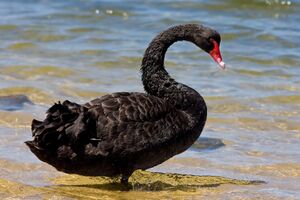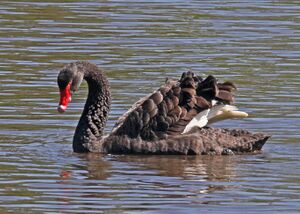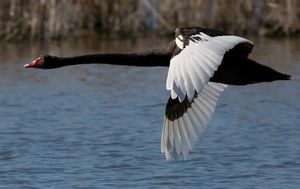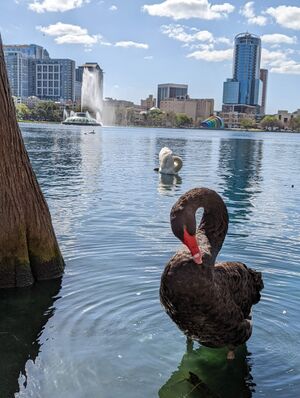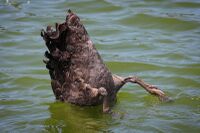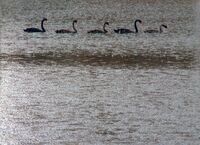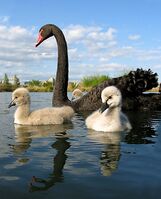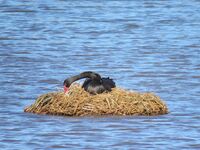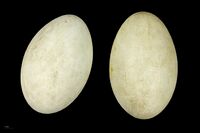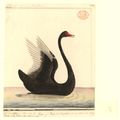بجعة سوداء
| البجعة السوداء Black Swan | |
|---|---|
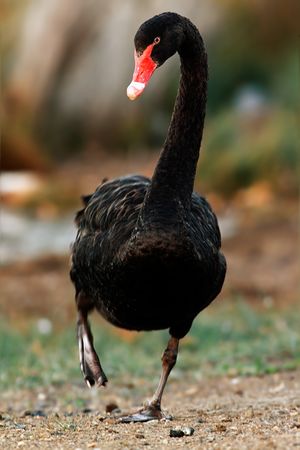
| |
| التصنيف العلمي | |
| مملكة: | |
| Phylum: | |
| Class: | |
| Order: | |
| Family: | |
| Genus: | |
| Species: | C. atratus
|
| Binomial name | |
| Cygnus atratus Latham, 1790
| |
| Subspecies | |
| |
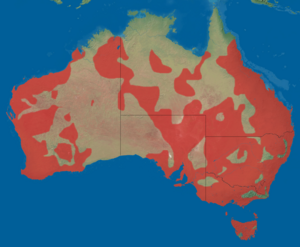
| |
| Synonyms | |
| |
البجعة السوداء Black Swan (اسمه العلمي Cygnus atratus) هي طائر مائي من جنس البجع، لونه أسود إلا أجزاء بيضاء من جناحيه ومنقاره الأحمر وعيونه. ويكبر الإوز الأسود حتى يبلغ طوله قرابة المتر. يعيش الإوز الأسود قرب البحيرات، والأنهار، والمستنقعات، في مناطق جنوب شرق وجنوب غرب أستراليا. Within Australia, the black swan is nomadic, with erratic migration patterns dependent on climatic conditions. It is a large bird with black plumage and a red bill. It is a monogamous breeder, with both partners sharing incubation and cygnet-rearing duties. ويأكل النباتات المائية والحيوانات المائية الصغيرة. وعشه مسطَّح مكوّن من النباتات المائية، ويبنى في المستنقع أو على الجزر. وتضع الأنثى من أربع إلى سبع بيضات كبيرة الحجم لونها أخضر شاحب.
يقوم الذكر والأنثى بحضانة البيض والاهتمام بالفراخ. وقد رأى الأوروبيون الإوز الأسود لأول مرة عام 1697م عندما قبض أعضاء حملة هولندية يقودها وليم دو فلامنج على أربعة منها على نهر الإوز في غرب أستراليا.
The black swan was introduced to various countries as an ornamental bird in the 1800s, but has managed to escape and form stable populations. Described scientifically by English naturalist John Latham in 1790, the black swan was formerly placed into a monotypic genus, Chenopis. Black swans can be found singly, or in loose companies numbering into the hundreds or even thousands.[1] It is a popular bird in zoological gardens and bird collections, and escapees are sometimes seen outside their natural range.
This bird is a regional symbol of both Western Australia, where it is native, and the English town of Dawlish, where it is an introduced species.[2]
. . . . . . . . . . . . . . . . . . . . . . . . . . . . . . . . . . . . . . . . . . . . . . . . . . . . . . . . . . . . . . . . . . . . . . . . . . . . . . . . . . . . . . . . . . . . . . . . . . . . . . . . . . . . . . . . . . . . . . . . . . . . . . . . . . . . . . . . . . . . . . . . . . . . . . . . . . . . . . . . . . . . . . . .
الوصف
Black swans are black-feathered birds, with white flight feathers. The bill is bright red, with a pale bar and tip; and legs and feet are greyish-black. Cobs (males) are slightly larger than pens (females), with a longer and straighter bill. Cygnets (immature birds) are a greyish-brown with pale-edged feathers.[1]
Mature black swans measure between 110 and 142 centimetres (43 and 56 in) in length and weigh 3.7–9 kilograms (8.2–19.8 lb). Their wing span is between 1.6 and 2 metres (5.2 and 6.6 ft).[1][3] The neck is long (relatively the longest neck among the swans) and curved in an "S"-shape.
The black swan utters a musical and far reaching bugle-like sound, called either on the water or in flight, as well as a range of softer crooning notes. It can also whistle, especially when disturbed while breeding and nesting.[1][4]
When swimming, black swans hold their necks arched or erect and often carry their feathers or wings raised in an aggressive display. In flight, a wedge of black swans will form as a line or a V, with the individual birds flying strongly with undulating long necks, making whistling sounds with their wings and baying, bugling or trumpeting calls.[1]
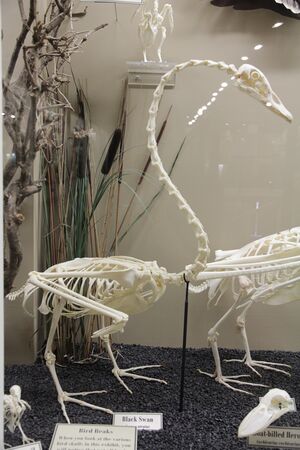
The black swan is unlike any other Australian bird, although in poor light and at long range it may be confused with a magpie goose in flight. However, the black swan can be distinguished by its much longer neck and slower wing beat.[5]
One captive population of black swans in Lakeland, Florida has produced a few individuals which are a light mottled grey colour instead of black.[6] White black swans are also known to exist; these individuals, which are leucistic, are believed to occur rarely in the wild.[7]
التوزع
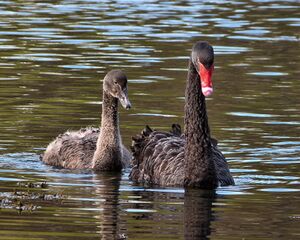
The black swan is common in the wetlands of southwestern and eastern Australia and adjacent coastal islands. In the south west its range encompasses an area between North West Cape, Cape Leeuwin and Eucla; while in the east it covers a large region bounded by the Atherton Tableland, the Eyre Peninsula and Tasmania, with the Murray Darling Basin supporting very large populations of black swans.[1][8] It is uncommon in central and northern Australia.
The black swan's preferred habitat extends across fresh, brackish and salt water lakes, swamps and rivers with underwater and emergent vegetation for food and nesting materials. It also favors permanent wetlands, including ornamental lakes, but can also be found in flooded pastures and tidal mudflats, and occasionally on the open sea near islands or the shore.[1]
The black swan was once thought to be sedentary, but is now known to be highly nomadic. There is no set migratory pattern, but rather opportunistic responses to either rainfall or drought. In high rainfall years, emigration occurs from the south west and south east into the interior, with a reverse migration to these heartlands in drier years. When rain does fall in the arid central regions, black swans will migrate to these areas to nest and raise their young. However, should dry conditions return before the young have been raised, the adult birds will abandon the nests and their eggs or cygnets and return to wetter areas.[9]
The black swan, like many other water fowl, loses all its flight feathers at once when it moults after breeding and is unable to fly for about a month. During this time it will usually settle on large, open waters for safety.[9]
The species has a large range, with figures between 1 and 10 million km2 given as the extent of occurrence. The current global population is estimated to be up to 500,000 individuals. No threat of extinction or significant decline in population has been identified with this numerous and widespread bird.[10]
Black swans were first seen by Europeans in 1697, when Willem de Vlamingh's expedition explored the Swan River, Western Australia.
التجمعات المُقدَمة
نيوزيلندا
Before the arrival of the Māori in New Zealand, a related species of swan known as the New Zealand swan had developed there, but was apparently hunted to extinction. In 1864, the Australian black swan was introduced to New Zealand as an ornamental waterfowl and populations are now common on larger coastal or inland lakes, especially Rotorua Lakes, Lake Wairarapa, Lake Ellesmere / Te Waihora, and the Chatham Islands.[4] Black swans have also naturally flown to New Zealand, leading scientists to consider them a native rather than exotic species, although the present population appears to be largely descended from deliberate introductions.[11]
المملكة المتحدة
The black swan is also very popular as an ornamental waterbird in western Europe, especially Britain, and escapees are commonly reported. As yet, the population in Britain is not considered to be self-sustaining and so the species is not afforded admission to the official British List,[12] but the Wildfowl and Wetlands Trust have recorded a maximum of nine breeding pairs in the UK in 2001, with an estimate of 43 feral birds in 2003–2004. A small population of black swans exists on the River Thames at Marlow, on the brook running through the small town of Dawlish in Devon, near the River Itchen, Hampshire, and the River Tees near Stockton on Tees.[13] The Dawlish population is so well associated with the town that the bird has been the town's emblem for forty years.[14]
اليابان
There are also wild populations in Japan, having originally been imported during 1950–1960.[15][16][17]
United States
Black swans have been reported in Florida, but there is no evidence that they are breeding; persistent sightings may be due to continual releases or escapes.[بحاجة لمصدر] Orange County, California reported black swans in Lake Forest, Irvine and Newport Beach on October 5, 2020, and Santa Ana in December 2021 in the “Versailles on the Lake” apartment community.[بحاجة لمصدر] The "Lake Forest Keys” community bought the original swans about eight to ten years ago and since then there have been many births and gaggles from the original couple" according to a report in the Orange County Register.[18][19] Black swans formerly resided in the vicinity of Lake Junaluska, a large lake in Waynesville, North Carolina.[20]
بر الصين الرئيسي
Black swans can also be found in mainland China.[21] In 2018 one group of swans was introduced to the Shenzhen University campus on an artificial lake in Guangdong Province.
السلوك
طعامه وإطعامه
The black swan is almost exclusively herbivorous, and while there is some regional and seasonal variation, the diet is generally dominated by aquatic and marshland plants. In New South Wales the leaf of reedmace (genus Typha) is the most important food of birds in wetlands, followed by submerged algae and aquatic plants such as Vallisneria. In Queensland, aquatic plants such as Potamogeton, stoneworts, and algae are the dominant foods. The exact composition varies with water level; in flood situations where normal foods are out of reach black swans will feed on pasture plants on shore.[22] The black swan feeds in a similar manner to other swans. When feeding in shallow water it will dip its head and neck under the water and it is able to keep its head flat against the bottom while keeping its body horizontal. In deeper water the swan up-ends to reach lower. Black swans are also able to filter feed at the water's surface.[23]
. . . . . . . . . . . . . . . . . . . . . . . . . . . . . . . . . . . . . . . . . . . . . . . . . . . . . . . . . . . . . . . . . . . . . . . . . . . . . . . . . . . . . . . . . . . . . . . . . . . . . . . . . . . . . . . . . . . . . . . . . . . . . . . . . . . . . . . . . . . . . . . . . . . . . . . . . . . . . . . . . . . . . . . .
الأعشاش والتكاثر
Like other swans, the black swan is largely monogamous, pairing for life (about 6% divorce rate).[24] Recent studies have shown that around a third of all broods exhibit extra-pair paternity.[25] An estimated one-quarter of all pairings are homosexual, mostly between males.[26][بحاجة لمصدر] They steal nests, or form temporary threesomes with females to obtain eggs, driving away the female after she lays the eggs.[27][28][29]
Generally, black swans in the Southern hemisphere nest in the wetter winter months (February to September), occasionally in large colonies. A black swan nest is essentially a large heap or mound of reeds, grasses and weeds between 1 and 1.5 metres (3–41⁄2 feet) in diameter and up to 1 metre high, in shallow water or on islands.[1][9] A nest is reused every year, restored or rebuilt as needed. Both parents share the care of the nest. A typical clutch contains four to eight greenish-white eggs that are incubated for about 35–40 days.[30] Incubation begins after the laying of the last egg, to synchronise the hatching of the chicks. Prior to the commencement of incubation the parent will sit over the eggs without actually warming them. Both sexes incubate the eggs, with the female incubating at night. The change over between incubation periods is marked by ritualised displays by both sexes.[31] If eggs accidentally roll out of the nest both sexes will retrieve the egg using the neck (in other swan species only the female performs this feat).[32] Like all swans, black swans will aggressively defend their nests with their wings and beaks.[33] After hatching, the cygnets are tended by the parents for about nine months until fledging.[1][4] Cygnets may ride on their parent's back for longer trips into deeper water, but black swans undertake this behaviour less frequently than mute and black-necked swans.[34]
A black swan and its nest at Booragoon Lake
Cygnus atratus – MHNT
العلاقة بالبشر

الحفاظ
The black swan is protected in New South Wales, Australia under the National Parks and Wildlife Act 1974 (s.5). The Black Swan is fully protected in all states and territories of Australia and must not be shot. [35] It is evaluated as Least Concern on the IUCN Red List of Threatened Species.[10]
الثقافة الأسترالية

The black swan was a literary or artistic image among Europeans even before their arrival in Australia. Cultural reference has been based on symbolic contrast and as a distinctive motif.
The black swan's role in Australian heraldry and culture extends to the first founding of the colonies in the eighteenth century. It has often been equated with antipodean identity, the contrast to the white swan of the northern hemisphere indicating 'Australianness'. The black swan is featured on the flag, and is both the state bird and state emblem of Western Australia; it also appears in the Coat of Arms and other iconography of the state's institutions. The Black Swan was the sole postage stamp design of Western Australia from 1854 to 1902.[36]
Indigenous Australia
The Noongar People of the South-West of Australia call the black swan Kooldjak along the West and South-West coast, Gooldjak in the South East and it is sometimes referred to as maali in language schools.[37]
انظر أيضاً
- Black swan theory, a theory about outlier events (such as Europeans discovering a black swan)
- List of Latin phrases (R): rara avis in terris nigroque simillima cygno ("a rare bird in the lands, and very like a black swan") Juvenal, Satires, VI
معرض صور
المصادر
- ^ أ ب ت ث ج ح خ د ذ Pizzey, G. (1984). A Field Guide to the Birds of Australia. Sydney: Collins. p. 66. ISBN 0-00-219201-2.
- ^ Smith, Colleen (2018-12-05). "So why are there black swans in Dawlish?". DevonLive (in الإنجليزية). Retrieved 2020-12-26.
- ^ "Cygnus atratus – Black swan (Species)". Wildlife1.wildlifeinformation.org. Archived from the original on 2011-09-30. Retrieved 2011-10-17.
- ^ أ ب ت Falla, R.A.; Sibson, R.B. & Turbott, E.G. (1981). The New Guide to the Birds of New Zealand and Outlying Islands. Auckland: Collins. p. 80. ISBN 0-00-217563-0.
- ^ Waterfowl in New South Wales, op. cit.: 25, 37–39
- ^ Rousos, Rick (December 27, 2002). "Mutant Swans Could Mean Hundreds of Dollars for City". The Lakeland Ledger. Archived from the original on 23 February 2014. Retrieved 19 February 2014.
- ^ "'Riddled with pellets': Rare swan found alive with eight gunshot wounds". ABC News (in الإنجليزية الأسترالية). 2021-05-08. Retrieved 2022-05-27.
- ^ Waterfowl in New South Wales. Sydney: CSIRO and NSW Fauna Panel. 1964. pp. 11–12.
- ^ أ ب ت Scott, Sir Peter, ed. (1982). The World Atlas of Birds. Balmain: Colporteur Press. pp. 200–1.
- ^ أ ب خطأ استشهاد: وسم
<ref>غير صحيح؛ لا نص تم توفيره للمراجع المسماةiucn status 12 November 2021 - ^ Narena Olliver (2010-10-28). "Black Swan (New Zealand birds)". Nzbirds.com. Retrieved 2011-10-17.
- ^ "BirdFacts – Black Swan". BTO. Retrieved 2009-11-06.
- ^ "Archant – Inspiring Communities". Archived from the original on 2015-05-02. Retrieved 2015-07-21.
- ^ Dawlish Live!(retrieved 7 March 2009)
- ^ Invasive Species of Japan : Cygnus atratus Retrieved July 27, 2016
- ^ Brazil, Mark Beauty versus the environment July 5, 2001 Japan Times Retrieved July 27, 2016
- ^ Swan dive into the strait dividing economic views February 21, 2011 Japan Times Retrieved July 27, 2016
- ^ "Why Australia's black swans are showing up in Orange County". 5 October 2020.
- ^ "Black Swan – Cygnus atratus" (PDF). Florida Fish and Wildlife Conservation Commission. 6 April 2020. Retrieved 6 April 2020.
- ^ Morrison, Jeremy (27 August 2014). "Malcolm's swan song". Smoky Mountain News. Retrieved 8 June 2017.
- ^ Stevens, Andrew (20 May 2016). "China's Silicon Valley: Lawns and pools but no free food". CNN Business. CNNMoney. Retrieved 6 April 2020.
- ^ Scott 1972, p. 75.
- ^ Scott 1972, pp. 59–60.
- ^ Kraaijeveld, Ken; Gregurke, John; Hall, Carol; Komdeur, Jan & Mulder, Raoul A. (May 2004). "Mutual ornamentation, sexual selection, and social dominance in the black swan". Behavioral Ecology. 15 (3): 380–389. doi:10.1093/beheco/arh023.
- ^ Kraaijeveld K, Carew PJ, Billing T, Adcock GJ, Mulder RA (June 2004). "Extra-pair paternity does not result in differential sexual selection in the mutually ornamented Black Swan (Cygnus atratus)". Mol. Ecol. 13 (6): 1625–33. doi:10.1111/j.1365-294X.2004.02172.x. PMID 15140105. S2CID 6934753.
- ^ Homosexual Animals Out of the Closet November 16, 2006 LiveScience Retrieved August 8, 2016
- ^ Braithwaite, L. W. (1981). "Ecological studies of the Black Swan III – Behaviour and social organization". Australian Wildlife Research. 8: 134–146. doi:10.1071/WR9810135.
- ^ Braithwaite, L. W. (1970). "The Black Swan". Australian Natural History. 16: 375–9.
- ^ Same-sex sexual behavior in birds: expression is related to social mating system and state of development at hatching (2007) 18 (1): 21–33. doi: 10.1093/beheco/arl065 Behavioral Ecology Retrieved August 8, 2016
- ^ Black Swans Archived مارس 9, 2007 at the Wayback Machine (at About.com)
- ^ Scott 1972, p. 99.
- ^ Scott 1972, p. 103.
- ^ Scott 1972, p. 101.
- ^ Scott 1972, p. 109.
- ^ Department of Jobs, Precincts and Regions (11 May 2020). "Non-gamebird information". Game Management Authority (in الإنجليزية الأسترالية). Archived from the original on 18 June 2020. Retrieved 27 September 2020.
- ^ "Western Australia - Black Swan". The Sun Never Sets on the Stamps of the British Empire. Smithsonian National Postal Museum. Retrieved 26 July 2022.
- ^ Fraser, Gina (2015). A HERITAGE IN NAMES – the Origin and Meaning of Street and Place Names in the City of South Perth (PDF). p. 51.
- BirdLife International (2004). Cygnus atratus. 2006 القائمة الحمراء للاتحاد العالمي للحفاظ على البيئة للأنواع المهددة. IUCN 2006. استرجعت في 2007-08-28.
وصلات خارجية
- Video, Pictures and Information on the Black Swan
- Black Swan videos on the Internet Bird Collection
- Learn How To Raise Swans
- CS1 الإنجليزية الأسترالية-language sources (en-au)
- Short description matches Wikidata
- أنواع القائمة الحمراء غير المهددة
- Articles with unsourced statements from January 2023
- Articles with unsourced statements from July 2022
- Articles with unsourced statements from August 2021
- بجع
- طيور أسترالية
- Black swans
- Birds described in 1790
- Birds of New South Wales
- Birds of Tasmania
- Birds of Victoria (state)
- Birds of Western Australia
- Cygnus (genus)
- Endemic birds of Australia
- Swans
- Taxa named by John Latham (ornithologist)

